
What is included with this book?
| EDITORS' NOTES | 1 | (12) | |
|
|||
| 1. Preparing Students for Educated Living: Virtues of Problem-Based Learning Across the Higher Education Curriculum | |||
|
|||
|
|||
| 2. Exploring the Tensions of Problem-Based Learning: Insights from Research | 13 | (12) | |
|
|||
|
|||
| 3. Designing Problems to Promote Higher-Order Thinking | 25 | (8) | |
|
|||
|
|||
| 4. Integrating Computers into the Problem-Solving Process | 33 | (6) | |
|
|||
|
|||
| 5. Problem Solving Through Design | 39 | (6) | |
|
|||
|
|||
| 6. Problem-Based Learning in an MBA Economics Course: Confessions of a First-Time User | 45 | (8) | |
|
|||
|
|||
| 7. Heuristics and Problem Solving | 53 | (6) | |
|
|||
|
|||
| 8. Fostering Collaboration Among Students in Problem-Based Learning | 59 | (8) | |
|
|||
|
|||
| 9. Guiding Students Toward Solutions in Field Experiences | 67 | (6) | |
|
|||
|
|||
| 10. Not All Metacognition Is Created Equal | 73 | (8) | |
|
|||
|
|||
| 11. Assessing Students' Problem-Solving Assignments | 81 | (8) | |
|
|||
|
|||
| INDEX | 89 |
The New copy of this book will include any supplemental materials advertised. Please check the title of the book to determine if it should include any access cards, study guides, lab manuals, CDs, etc.
The Used, Rental and eBook copies of this book are not guaranteed to include any supplemental materials. Typically, only the book itself is included. This is true even if the title states it includes any access cards, study guides, lab manuals, CDs, etc.